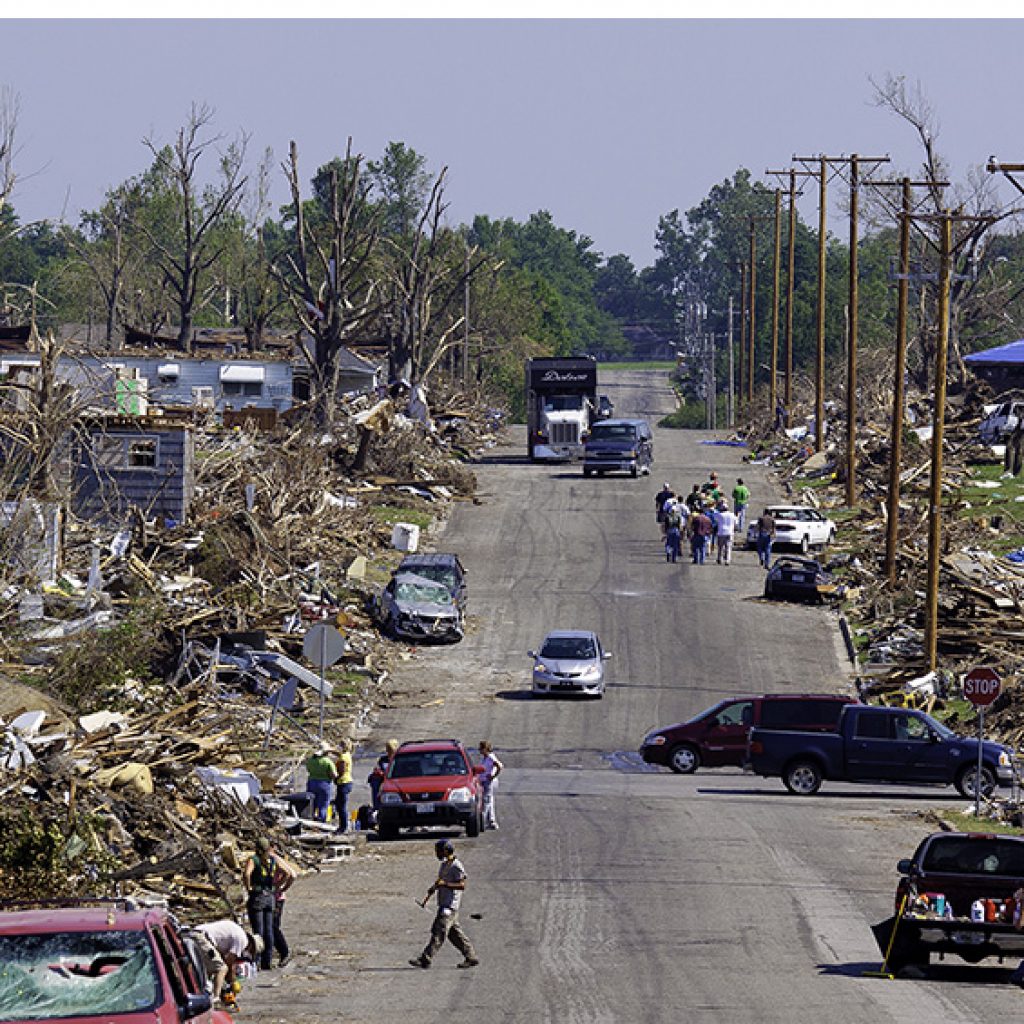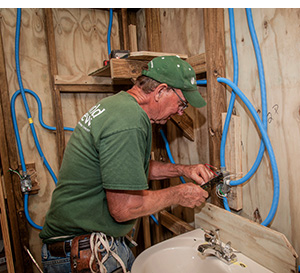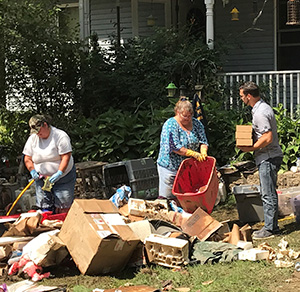
By Ed Sanow
Church members want to help when a weather-related disaster occurs, but they often don’t know what to do. When this happens, they may think they can’t do anything. To best show Jesus’ hands and heart in the wake of such occurrences, members need to know how to prepare for and respond to weather emergencies.
The first step in “external disaster planning” involves church leadership answering the question, “What is the church’s plan for responding to a weather disaster in our community?” The answer has three components: church members, church facilities, and church leadership.

There is a job for everyone at a disaster site, but some tasks may require certified or bonded contractors. (Photo courtesy of FEMA)
Community-Focused Disaster Planning
The church should first collect “skill set” information on all church members who are interested in helping. There is a job for everyone at a disaster site. Those with limited skills or physical abilities can simply deliver or hand out water and food. Those with general skills may join in a cleanup crew. Those with specialized skills might include chainsaw operators and roofers. And finally, those with certified skills include electricians and other contractors.
In some areas—and this varies by state—repair work needs to be performed by people who are certified, licensed, and/or bonded.
The church should then assess its facilities by conducting a review. Could your multipurpose room be used as an emergency shelter or short-term housing or a long-term base camp? How many showers does your church have? Do you have a commercial or institutional kitchen?
The final step is to select leaders for the disaster response. The primary leader for the recovery effort should not be the senior minister, since they will have many other disaster duties. (By the way, IDES has developed a course for self-care and the emotional well-being of ministers involved in disaster operations.)
Instead of the senior minister, select a member with a background in emergency services or construction. An elder, deacon, or trustee of the church would be ideal. Decide who will serve as liaison with emergency management, who will register and coordinate volunteers, and who will handle the donated funds and goods.
Church-Focused Disaster Planning
“Internal disaster planning”—meaning the internal, church-focused disaster plan—should follow standard advice that comes directly from the Federal Emergency Management Agency (FEMA). Among the questions that must be answered: Who will coordinate the building evacuation or shelter-in-place? Who will conduct the headcount for staff and volunteers? Who is responsible for communications and the emergency contact lists?
Finally, who is responsible for developing and maintaining a 72-hour emergency kit? This kit will include food, water, medicine, flashlights, batteries, and copies of insurance documents. Importantly, it also will include an extensive first aid kit, one which can even contend with chainsaw injuries and broken bones.
An important aspect of disaster planning is updating a homeowner and/or church insurance policy. Seek a better understanding of the deductible and what is and is not covered. (About 80 percent of the homes destroyed by floodwaters from the 2017 hurricanes did not have flood insurance.) Update the current replacement values. Understand that some items may need to have a special rider (to cover items not covered by a blanket or general policy). The best solution to a weather disaster is a good insurance policy!
Hazardous Conditions and PPE
The state-level voluntary organizations active in disasters (or VOADs) typically issue two reminders to their counterparts at the county level. First, volunteers need to wear personal protective equipment. Second, all volunteers need to be affiliated with a disaster relief organization—that is, they should not simply show up as spontaneous volunteers. FEMA states, “Unfortunately, untrained, unaffiliated, spontaneous volunteers all too often end up becoming injured.”
Disaster sites are dangerous areas with many hazards: broken glass, splintered wood, sharp plastic, ripped steel, contaminated floodwater. Half the injuries associated with a tornado occur during the cleanup process after the tornado has passed.
The hazardous conditions require personal protective equipment such as long pants, long-sleeve shirts, N95 masks, heavy leather work gloves, eye protection, head protection, and (most significantly) proper footwear.

Lessons Learned from Superstorm Sandy
The Wheaton College Humanitarian Disaster Institute studied the overall response by churches during Superstorm Sandy (2012) and came up with two important “lessons learned.”
First, churches should identify ministries in which they already excel and plan now for how to expand what they are already doing. Does your church already have a strong children’s ministry or a ministry to feed senior citizens? Is your church involved in cleanup operations with a neighborhood mission? Does it have expertise in counseling? Does it have a strong ministry to people who are disabled or have special needs? Does it serve through a clothing or shoe distribution?
For example, if your church has a youth program involving 100 kids, what will it take to handle 300 kids? The church already knows what it takes, and the youth program’s staff has already gone through background checks. Simply figure out how to handle a much larger number of kids.
Conversely, churches should not immediately start a new program in response to a disaster. If you are not currently doing an outreach activity, don’t start one early on during recovery operations because the learning curve is far too great. Instead, expand what you are already doing.
If your church doesn’t presently have an active community outreach effort, consider something like a “Great Day of Service.” A couple of times a year, gather a large number of people from your church, go into the community, and do whatever it takes to help . . . paint, wash windows, fix doors or porches, clean up trash, sort clothing, landscape, clean gutters, trim trees, or repair siding.
This sort of cleanup outreach benefits the community, but it also benefits the church. It not only is an evangelistic outreach, but these activities are exactly what you will be doing in the wake of a weather disaster. So, a service day is sort of like a practice run for disaster response. It will help build leadership, communication, and coordination skills your church will need to respond to a disaster.
The second major “lesson learned” from Superstorm Sandy was that a church should get to know their area’s disaster response organizations, the key one being their county’s emergency management agency which is in charge of the disaster response. Invite them to your church to give a presentation. It’s helpful that they know what assistance your church and church members can bring to a local disaster.
The church also needs to know what the county’s emergency management agency will need . . . help with feeding people, emergency shelter, short-term housing, staging areas, or a large pool of volunteers. You want your church to be so well-known by emergency management that they will call you after a disaster (instead of you calling them).

More Lessons Learned
The church should also get to know the nongovernment organizations (NGOs) in their area. These volunteer organizations include the American Red Cross, Salvation Army, United Way, Goodwill, as well as other church groups.
These volunteer organizations typically meet on a periodic basis. The collective can go by several different names: COAD (community organizations active in disasters); VOAD (voluntary organizations active in disasters); Citizen Corps; LEPC (local emergency planning council); Reserve Medical Corps; or LTRO (long-term recovery organization). These assistance groups need to know one another’s capabilities.
Be careful with donated goods. After a weather disaster, churches typically are tempted to gather goods for disaster relief. According to FEMA, “Unsolicited donation of water, clothes and other items often significantly challenges the relief effort.” Most donations don’t meet the immediate needs of the disaster survivors. The goods either are unsuitable or arrive at the wrong time. An estimated 60 percent of donations to a disaster site are not needed.
Asking “what do you need?” isn’t all that helpful because it isn’t possible to get them what they need “right now.” Disaster sites change so rapidly that what they need now will be different from what they need a week from now. It is better for the church to ask “what will you need next?” and “when will you need it?”
This is a good rule to follow: Don’t gather or send anything unless you know there is a need for it and that you can get it there when it’s needed. Churches (and individuals) need to follow their heads rather than their hearts with respect to donated goods, which have been called “the disaster after the disaster.”
The website HowStuffWorks.com developed a list of the “10 Worst Things to Donate after a Disaster” based on a 20-year study of experiences from Hurricane Andrew (in 1992) through Superstorm Sandy. The list included used clothing, used shoes, blankets, teddy bears, medicine, pet supplies, items mixed in the same box, canned food and bottled water, unsolicited help, and money sent to wrong relief groups and GoFundMe pages. (FEMA’s position is very clear: “The best place to donate money is to voluntary organizations.”)
The better we plan now, the better we will be able to respond to the next inevitable weather disaster.
Ed Sanow serves as director of training with International Disaster Emergency Service (IDES) and is FEMA-certified as a community emergency response team member. For more information on the full four-hour “Prepare to Respond” in-church training program, go to www.ides.org/contact.

The church is not an insurance company here to replace losses for the rich. There is no need to provide money to one who may have taken some weather-related losses. If they are not truly needy why give them anything? There are plenty of needy in the world outside of U.S. borders who need help. The fatherless and the widow in distress are two examples. Try sending the fatherless to the University in Indonesia so they can forever rise above the poverty they were each born into. Turn them into nurses, doctors, engineers and accountants and that will do real good in the world. Americans have insurance. They also have the government. They have education and plenty of resources available to them, but your brothers in Christ in countries like Indonesia, India, the Philippines, Thailand and Vietnam do not have such resources.
As an elder in the author’s church, I can attest that Ed’s heart and giftedness in this area is remarkable. For Mr. Thiede to suggest that the church replaces losses for the rich is a gross misinterpretation. These type of divisive comments are yet another sad example of why nonbelievers are turned off by the church. Properly stewarding God’s resources is a very important aspect of ministry. Being prepared to take care of the local church as well as the international church is not mutually exclusive.
Thank you Ed for this excellent article! You are such a blessing to so many! I’m thankful for IDES and the incredible work they continue to do and thankful our church is a partner in this ministry!